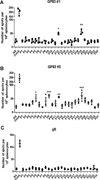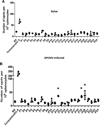Development of a novel, guinea pig-specific IFN-γ ELISPOT assay and characterization of guinea pig cytomegalovirus GP83-specific cellular immune responses following immunization with a modified vaccinia virus Ankara (MVA)-vectored GP83 vaccine
- PMID: 24856783
- PMCID: PMC4279957
- DOI: 10.1016/j.vaccine.2014.05.011
Development of a novel, guinea pig-specific IFN-γ ELISPOT assay and characterization of guinea pig cytomegalovirus GP83-specific cellular immune responses following immunization with a modified vaccinia virus Ankara (MVA)-vectored GP83 vaccine
Abstract
The guinea pig (Cavia porcellus) provides a useful animal model for studying the pathogenesis of many infectious diseases, and for preclinical evaluation of vaccines. However, guinea pig models are limited by the lack of immunological reagents required for characterization and quantification of antigen-specific T cell responses. To address this deficiency, an enzyme-linked immunospot (ELISPOT) assay for guinea pig interferon (IFN)-γ was developed to measure antigen/epitope-specific T cell responses to guinea pig cytomegalovirus (GPCMV) vaccines. Using splenocytes harvested from animals vaccinated with a modified vaccinia virus Ankara (MVA) vector encoding the GPCMV GP83 (homolog of human CMV pp65 [gpUL83]) protein, we were able to enumerate and map antigen-specific responses, both in vaccinated as well as GPCMV-infected animals, using a panel of GP83-specific peptides. Several potential immunodominant GP83-specific peptides were identified, including one epitope, LGIVHFFDN, that was noted in all guinea pigs that had a detectable CD8+ response to GP83. Development of a guinea pig IFN-γ ELISPOT should be useful in characterization of additional T cell-specific responses to GPCMV, as well as other pathogens. This information in turn can help focus future experimental evaluation of immunization strategies, both for GPCMV as well as for other vaccine-preventable illnesses studied in the guinea pig model.
Keywords: CMV pp65; Congenital CMV infection; Cytomegalovirus vaccine; ELISPOT; Glycoprotein B; Guinea pig; Guinea pig cytokine; Guinea pig immunology; IFN-γ; Interferon gamma; Placenta; TORCH infection; pp65.
Copyright © 2014 Elsevier Ltd. All rights reserved.
Conflict of interest statement
Figures




Similar articles
-
Comparison of monovalent glycoprotein B with bivalent gB/pp65 (GP83) vaccine for congenital cytomegalovirus infection in a guinea pig model: Inclusion of GP83 reduces gB antibody response but both vaccine approaches provide equivalent protection against pup mortality.Vaccine. 2015 Jul 31;33(32):4013-8. doi: 10.1016/j.vaccine.2015.06.019. Epub 2015 Jun 13. Vaccine. 2015. PMID: 26079615 Free PMC article.
-
A Fully Protective Congenital CMV Vaccine Requires Neutralizing Antibodies to Viral Pentamer and gB Glycoprotein Complexes but a pp65 T-Cell Response Is Not Necessary.Viruses. 2021 Jul 27;13(8):1467. doi: 10.3390/v13081467. Viruses. 2021. PMID: 34452332 Free PMC article.
-
Guinea pig cytomegalovirus protective T cell antigen GP83 is a functional pp65 homolog for innate immune evasion and pentamer dependent virus tropism.J Virol. 2021 Apr 26;95(10):e00324-21. doi: 10.1128/JVI.00324-21. Epub 2021 Mar 3. J Virol. 2021. PMID: 33658350 Free PMC article.
-
Comparison of vaccine strategies against congenital CMV infection in the guinea pig model.J Clin Virol. 2008 Mar;41(3):224-30. doi: 10.1016/j.jcv.2007.10.008. Epub 2007 Dec 3. J Clin Virol. 2008. PMID: 18060834 Review.
-
Animal models of congenital cytomegalovirus infection: an overview of progress in the characterization of guinea pig cytomegalovirus (GPCMV).J Clin Virol. 2002 Aug;25 Suppl 2:S37-49. doi: 10.1016/s1386-6532(02)00100-2. J Clin Virol. 2002. PMID: 12361755 Review.
Cited by
-
Detection of herpes simplex virus type 2 (HSV-2) -specific cell-mediated immune responses in guinea pigs during latent HSV-2 genital infection.J Immunol Methods. 2016 Dec;439:1-7. doi: 10.1016/j.jim.2016.09.004. Epub 2016 Sep 19. J Immunol Methods. 2016. PMID: 27659010 Free PMC article.
-
Additive Protection against Congenital Cytomegalovirus Conferred by Combined Glycoprotein B/pp65 Vaccination Using a Lymphocytic Choriomeningitis Virus Vector.Clin Vaccine Immunol. 2017 Jan 5;24(1):e00300-16. doi: 10.1128/CVI.00300-16. Print 2017 Jan. Clin Vaccine Immunol. 2017. PMID: 27795301 Free PMC article.
-
Asthma: The Use of Animal Models and Their Translational Utility.Cells. 2023 Apr 5;12(7):1091. doi: 10.3390/cells12071091. Cells. 2023. PMID: 37048164 Free PMC article. Review.
-
Cytomegalovirus Vaccines: Current Status and Future Prospects.Drugs. 2016 Nov;76(17):1625-1645. doi: 10.1007/s40265-016-0653-5. Drugs. 2016. PMID: 27882457 Free PMC article. Review.
-
Prophylactic Herpes Simplex Virus 2 (HSV-2) Vaccines Adjuvanted with Stable Emulsion and Toll-Like Receptor 9 Agonist Induce a Robust HSV-2-Specific Cell-Mediated Immune Response, Protect against Symptomatic Disease, and Reduce the Latent Viral Reservoir.J Virol. 2017 Apr 13;91(9):e02257-16. doi: 10.1128/JVI.02257-16. Print 2017 May 1. J Virol. 2017. PMID: 28228587 Free PMC article.
References
-
- Hickey AJ. Guinea pig model of infectious disease - viral infections. Curr Drug Targets. 2011;12:1018–1023. - PubMed
-
- Kaufmann SHE, Gengenbacher M. Recombinant live vaccine candidates against tuberculosis. Curr Opin Biotechnol. 2012;23:900–907. - PubMed
-
- Lin F, Shen XF, McCoy JR, Mendoza JM, Yan J, Kemmerrer SV, et al. A novel prototype device for electroporation-enhanced DNA vaccine delivery simultaneously to both skin and muscle. Vaccine. 2011;29:6771–6780. - PubMed
Publication types
MeSH terms
Substances
Grants and funding
LinkOut - more resources
Full Text Sources
Other Literature Sources
Medical
Molecular Biology Databases
Research Materials

